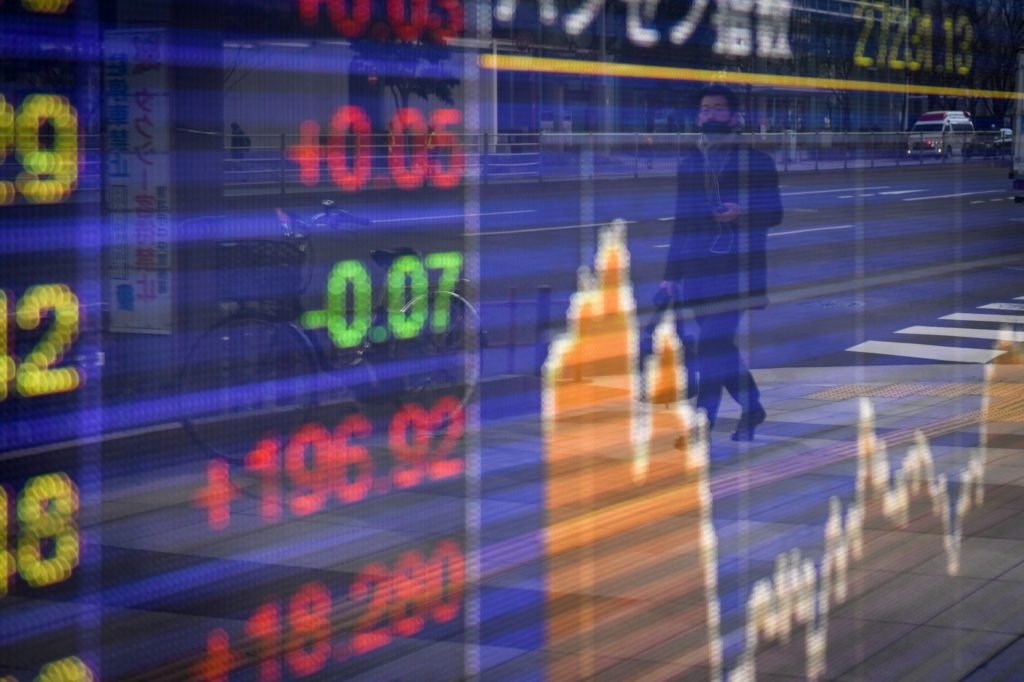(Bloomberg) — Asian stocks followed their U.S. peers lower Friday as traders weighed the economic threat of virus restrictions against optimism about the efficacy of vaccines.
Equity markets declined across Asia, and European futures declined. U.S. contracts were little changed after benchmarks ended a three-day rally amid losses consumer discretionary and real estate stocks. Treasuries were steady, with a lackluster sale of 30-year bonds paring gains on Thursday. Oil traded below $71 per barrel and Bitcoin fluctuated. The dollar held overnight gains.
Chinese markets are in investors’ focus after China Evergrande Group and Kaisa Group Holdings Ltd. officially defaulted on their dollar debt. Evergrande shares fell about 2%. Kaisa’s shares, which are also traded in Hong Kong, remained suspended.
China’s central bank took further steps to limit the yuan’s strength — setting the weakest reference rate relative to estimates compiled by Bloomberg since 2018 — a day after policy makers raised the foreign currency reserve requirement ratio for banks a second time this year. The yuan shrugged off the moves to advance further.
Investors are mulling the cost to contain the omicron strain amid mounting concern it will crimp the economic rebound. A study has found omicron is 4.2 times more transmissible than the delta variant in its early stages.
“Ultimately the issue from a health perspective is that even if Omicron does prove to be less severe — which the initial indications so far have pointed to — a rise in transmissibility could offset that,” said a team of Deutsche Bank strategists including Jim Reid. That could mean that more people are in the hospital, “even if a lower proportion of them are severely affected.”
Meanwhile, the global equity rally faces further road bumps ahead from U.S. consumer inflation numbers on Friday and a Federal Reserve meeting next week that may give clues on the pace of tapering and interest rate increases.
“Various FOMC participants, including Chair Powell, have signaled a hawkish shift in their policy stance, catalyzed by increasing discomfort with elevated inflation against a backdrop of robust growth and ongoing strengthening in labor markets conditions,” Morgan Stanley economists and strategists including Ellen Zentner, wrote in a note Thursday. “We revise our Fed call and now expect the FOMC to begin raising rates in Sept. 2022 — two quarters earlier than our prior forecast.”
The dollar was flat. It rose Thursday after a report showed applications for U.S. state unemployment benefits declined to the lowest level since 1969. However, economists flagged difficulties in seasonal adjustments to arrive at that figure.
Bloomberg’s Markets Live team is running a survey on asset views for 2022. It’s anonymous, takes about 2 minutes, and the results will be shared in the latter part of December.
Here are some key events to watch this week:
U.S. CPI Friday
Some of the main moves in markets as of 7:12 a.m. in London:
Stocks
- S&P 500 futures gained 0.1%. The index fell 0.7% Thursday.
- Nasdaq 100 futures were flat. The benchmark fell 1.5% Thursday.
- Topix fell 0.8%.
- Hang Seng dropped 1.2%.
- Shanghai Composite declined 0.2%.
- The S&P/ASX 200 dropped 0.4%.
- Kospi declined 0.6%.
- Euro Stoxx 50 futures fell 0.5%.
Currencies
- The Bloomberg Dollar Spot Index advanced 0.1%.
- The euro was little-changed at $1.1291.
- The Japanese yen was flat at 113.55 per dollar.
- The offshore yuan was at 6.3717.
Bonds
- The yield on 10-year Treasuries gained about one basis point to 1.51%.
- The yield on Australia’s 10-year bonds dropped about four basis points to 1.64%.
Commodities
- West Texas Intermediate crude fell 0.4% to $70.67 a barrel.
- Gold fell 0.1% to $1,773.01 an ounce.
More stories like this are available on bloomberg.com
©2021 Bloomberg L.P.











